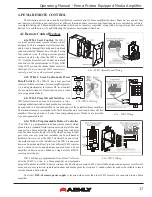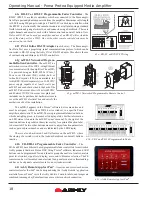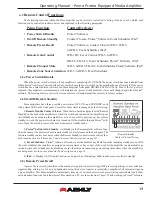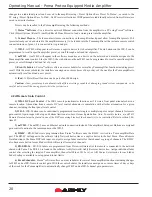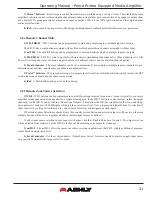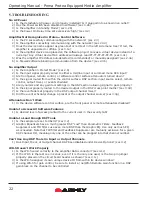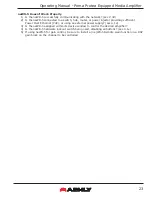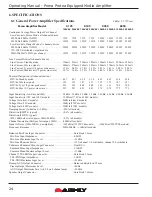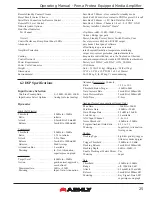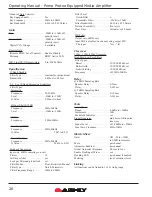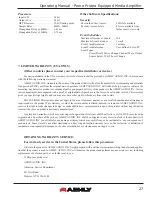
Operating Manual - Pema Protea Equipped Media Amplifier
12
Channel Thermal
- This software LED indicator becomes lit when the channel is operating at an excessive and unsus-
tainable temperature.
Channel Protect
- This becomes lit when any amplifier channel is switched into protect mode, meaning one or more fault
conditions are occurring. Fault conditions include overvoltage, overcurrent, and overtemperature.
Fuse Protect
- This means that the amplifier has automatically attenuated the signal in order to prevent an internal non-
user-serviceable fuse from blowing.
Rail Fault
- This means that the output power supply has encountered a rail overvoltage fault.
Supply Fault
- This means there is a general power supply fault. Fault conditions include fuse protect, overtemperature,
and overcurrent.
Stereo/Bridged selection
- The drop-down selection box above each pair of adjacent
channels assigns stereo or bridge mode for that pair. In bridge mode, input signal is auto-
matically taken from the odd channel input and inverted, then sent to the even channel. The
even channel controls become disabled. Note that in bridge mode, the even channel software
attenuators will still reflect the physical position of the amplifier's front panel attenuators,
even though they are removed from control of bridged signal.
Channel Name
- This user defined text box names the amplifier output channel. Up
to 20 characters can be used.
Clip/Mute LED
- This LED shows when the amplifier output is either muted or clip-
ping. Clipping is indicated when the output level is 1/2 Volt below the output power supply
rails, and accurately tracks AC line voltage sags. All outputs become muted when the unit
is put in standby mode. This LED always shows the same status as the amplifier front panel
clip/mute LED.
Mute Button
- This button mutes the output channel. Output mute can be controlled
by the event scheduler.
Polarity Button
- This button inverts the polarity of the output channel signal.
Main Output Channel Fader
- This controls the output attenuation. Output attenua-
tion below -40dB mutes the output.
Input Meter
- This indicates the signal level in dBu as in arrives at the amplifier section.
Output Meter
- This indicates the amplifier output level in dB below full rated output.
Protect LED
- This individual channel protect LED indicates an overvoltage, overcur-
rent, or overtemperature fault.
Current Meter
- This shows that the amplifier is delivering current to a load, and is
useful to determine if a speaker load is open or shorted.
Temperature Meter
- This meter and temperature box show the current operating tem-
perature of the output devices. Excess of 100°C will trigger overtemperature protection.
Offset Link Group and Offset Faders
- A group of output channels can be linked together
to attenuate the group as a whole without changing the relative levels of each channel. If a channel is assigned to one of the 16
offset link groups, a colored triangular marker appears on the left side of the main fader graticule for secondary level control
of all channels in that group. Left click and drag this marker up or down to adjust the link group level. The main level control
faders can not be linked to a group. Note that more than 40dB of cumulative channel attenuation causes the channel to mute.
In addition to the control surface offset link group attenuator control (not the main fader), most DSP functions have a link
group check box in their work window to assign a specific DSP parameter to one of 16 link groups if desired. Link groups can
be renamed by clicking on any group name and entering the new name then pressing <enter> on the keyboard.
3.4a - Pema Control Surface
Channel Functions

















